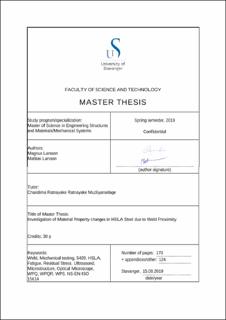| dc.contributor.advisor | RM Ratnayake, Chandima | |
| dc.contributor.author | Larsson, Magnus | |
| dc.contributor.author | Larsson, Mattias | |
| dc.date.accessioned | 2020-03-02T14:09:25Z | |
| dc.date.available | 2020-03-02T14:09:25Z | |
| dc.date.issued | 2019-09-15 | |
| dc.identifier.uri | http://hdl.handle.net/11250/2644730 | |
| dc.description | Master's thesis in Mechanical engineering | nb_NO |
| dc.description.abstract | Standards and specifications apply a rule of thumb when determining the distance of two adjacent weld joints, but they rarely give any clear technical justification for the predetermined values. It is vital to understand the implications it has on mechanical and material properties of the weld joint when exceeding these set requirements. The objective of this thesis was aimed at obtaining quantifiable data regarding the implications of having two adjacent weld joints in close proximity.
An experimental analysis was designed where the resulting material behavior was analyzed and documented. The test consisted of six welded 500x300x15 mm S420G2+M steel plates, each having two adjacent parallel butt welds along its full length. The distances between two adjacent welds were 50, 15 and 5 mm in order to analyze the effect a variation in distance have on the properties of the initial weld pass.
All plates were welded at KIWA in Stavanger, and subsequently mechanically tested at Quality Lab in Forsand in accordance with NS-EN ISO 15614-1:2017. A WPQ was established in order to maintain conformance in all subsequent welding operations and ensure replicability of the experiment. Fatigue test and microstructural analysis (optical microscope) was conducted at the Department of Mechanical and Structural Engineering and Materials Science at the University of Stavanger. Residual stress analysis was conducted at Veqter in Bristol using ultrasound (US), Incremental Centre-Hole Drilling (ICHD) and X-ray Diffraction (XRD) technique.
The mechanical testing results from Qlab showed no reduction in the material properties from the tested specimens based on tensile tests, Charpy V Impact toughness test and Vickers hardness test. This was despite that the closest adjacent weld toes were 1.3 mm. There was no clear difference between the different results from the tests.
An optical microscope was used during the microstructural examination of three specimens with different weld to weld distances; 44 mm, 12 mm and 1.3 mm. Based on the observed microstructure in the WM and HAZ the welds at 44 mm and 12 mm between the weld toes had no visible microstructural effect. The weld that had 1.3 mm between the weld toes had a clear HAZ overlap. It did not seem to be any harmful microstructural changes in the HAZ and the heat from the secondary weld appeared to have had a normalizing effect on the initial HAZ. The results from the mechanical testing supported this observation. Because of the limitations in magnification of the optical microscope, further testing should be conducted in order to assure that this is the case. This also requires the addition of SEM and TEM results.
The objective of the fatigue test was to assess if any reduction in fatigue strength had occurred due to the weld proximity situation. The fatigue test specimens were prepared with the intention to isolate and study the microstructure. The preparation of the sample were conducted in accordance with ASTM E466-15 for a homogenous material subjected to high-cycle fatigue. Weld discontinuities was avoided in order to isolate and focus on the HAZ microstructure, and any geometrical and angular weld stress concentrations was removed. The result from the test was that the specimen at 5 mm distance with overlapping welds seemed to have failed in the secondary weld. The reason for the crack initiation was not possible to determine. Important to note though, was that the failure did not occur in the first weld, which was the focus of the study, but the secondary overlapping weld. In the absence of stress concentrations, the remaining fatigue specimens failed in the parent metal. The sample size was limited, but the results indicated that at 12 mm between two weld toes, the weld has the higher fatigue strength.
The majority of ultrasonic (US) residual stress tests that were performed showed longitudinal tensile and a compressive transverse residual stress in both the weld cap and the root of tested specimens. It was surprising to find compressive transverse residual stress in the weld, but all the subsequent residual stress test methods performed supported this result. This included XRD and ICHD. A Contour measurement planned in the future will provide the longitudinal residual stress and will be used as an additional source for calibration.
The findings in this report can assist in the assessment of a weld proximity or weld-on-weld scenarios. The welding operation did not seem to introduced any degradation of the material properties in the WM and HAZ. The mechanical properties of similar weld joints in the field could be assumed to be unaffected due to the welding of an adjacent weld.
Important to note is that this is for this type of method and materials. More testing has to be performed in other to ascertain the findings. The results can be used as a baseline for further research. | nb_NO |
| dc.language.iso | eng | nb_NO |
| dc.publisher | University of Stavanger, Norway | nb_NO |
| dc.relation.ispartofseries | Masteroppgave/UIS-TN-IMBM/2019; | |
| dc.rights | Navngivelse 4.0 Internasjonal | * |
| dc.rights.uri | http://creativecommons.org/licenses/by/4.0/deed.no | * |
| dc.subject | maskinteknikk | nb_NO |
| dc.subject | fatigue | nb_NO |
| dc.subject | stress | nb_NO |
| dc.subject | ultralyd | nb_NO |
| dc.subject | WPQ | nb_NO |
| dc.subject | WPQR | nb_NO |
| dc.subject | HSLA | nb_NO |
| dc.subject | microstructure | nb_NO |
| dc.subject | mekanisk testing | nb_NO |
| dc.title | Investigation of Material Property changes in HSLA Steel due to Weld Proximity | nb_NO |
| dc.type | Master thesis | nb_NO |
| dc.subject.nsi | VDP::Technology: 500::Mechanical engineering: 570::Machine construction and engineering technology: 571 | nb_NO |

